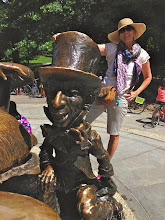On a wonderful cloudy, rainy Saturday I attended a fabulous workshop at
Summerland Mercantile
http://summerlandmercantile.com
The workshop was held at the proprietor's GORGEOUS home in Summerland
which is just south of Santa Barbara.
And what was the wonderful workshop about…
SHIBORI: the Japanese tie-dyeing technique from the 8th century.
It is a form of resist dyeing that probably came from China.
Indigo dye is the most common dye used with shibori.
Historically shibori and indigo dye was used by the poor to renew their hemp clothing.
During the 18th century it became fashionable with the very rich but,
the shibori techniques were used on silk and the the designs were
extremely intricate.
Each workshop participant was given a muslin tote, a silk scarf, and two large squares of cotton fabric.
1) Kumo - a twist and bind technique
2) Itajime - a shape resist technique
3) Nui - a stitched technique
The techniques can be combined and everyone got busy manipulating their fabrics.
About an hour later it was time to move onto the Indigo dyeing.
Outside there were dye stations set up for each student.
This was a wonderful, well planned workshop.
Kaari Meng was our instructor for the workshop.
Previously I attended a quickie indigo workshop with her.
She has been using these techniques and indigo dyes for years.
Kaari is the owner of an amazing, inspiring, treasure filled
1926 pink adobe store in the Silverlake neighborhood of LA
French General
https://www.frenchgeneral.com
Every student mixed a small amount of indigo dye with soda ash into a water filled bucket.
Very important to stir in one direction only until bubbles form at the top.
DO NOT stir through the bubbles ( bubbles are called the bloom )
Stir ONE time only in the opposite direction and then let dye sit for 45 minutes before using.
Before putting any item in the dye the bloom is scooped out from the dye.
Indigo dye starter kits are available at Dharma Trading Co.http://www.dharmatrading.com
So here is my plain heavy canvas tote.
I decided to use the Kumo technique -
twisting sections over small objects and binding it with rubber bands or string.
Ready for the next step;
Almost all dyeing requires soaking the fabric in water so the dyes will penetrate more easily
Finally time to dye !
Hold piece in the dye bath for a few minutes.
When items are removed from the indigo dye the color is a beautiful turquoise green.
Air oxidizes the color to a brilliant blue and then it is time to place in the indigo dye again.
And again and again and again.
The more times in the indigo the more brilliant the final blue.
When the blue is the desired hue items are rinsed in cold water.
This stops the dye process and rinse until no blue run-off.
I also soaked my items for 24 hours in a 1 part white vinegar to 3 part water
to help set the color.
And this is the end result for my tote bag.
The small circles where created by twisting fabric around corks.
The large circles were twisted around ping pong balls.
With practice the results can be pretty controlled and consistent.
For one of the cotton fabric squares I used the Itajime technique- folding the fabric accordion style
and then sandwiching it between flat items that were FIRMLY clamped.
and this was my end result.
Not as pretty as I had hoped.
I really wanted to have a success with the silk scarf.
I used the Nui technique - a simple running stitch that is pulled very tight and knotted off.
I confess I saw this half circle technique in one of the shibori books that Kaari brought.
She has never done this particular stitch pattern so I was on my own.
The two ends of the scarf were folded evenly, next I traced half circles and then did the running stitch.
The end result is very pretty and probably my most successful shibori technique.

The shibori techniques and indigo dyeing combinations are endless.
There were so many amazingly beautiful end results.
It was very much like playing the lottery…
everyone really hoped their finished piece would be a winner.
Some were definitely more successful than others.
But the shibori techniques and the indigo dye process worked for every participant and that is what was important.
Many of the people were already extremely skilled at shibori and indigo dyeing.
One woman even had indigo plane seeds she was giving away from her indigo plants
At the end of the day it was a wonderful,
educational, interesting, fun
experience.
And I think that's what life is all about.





















































